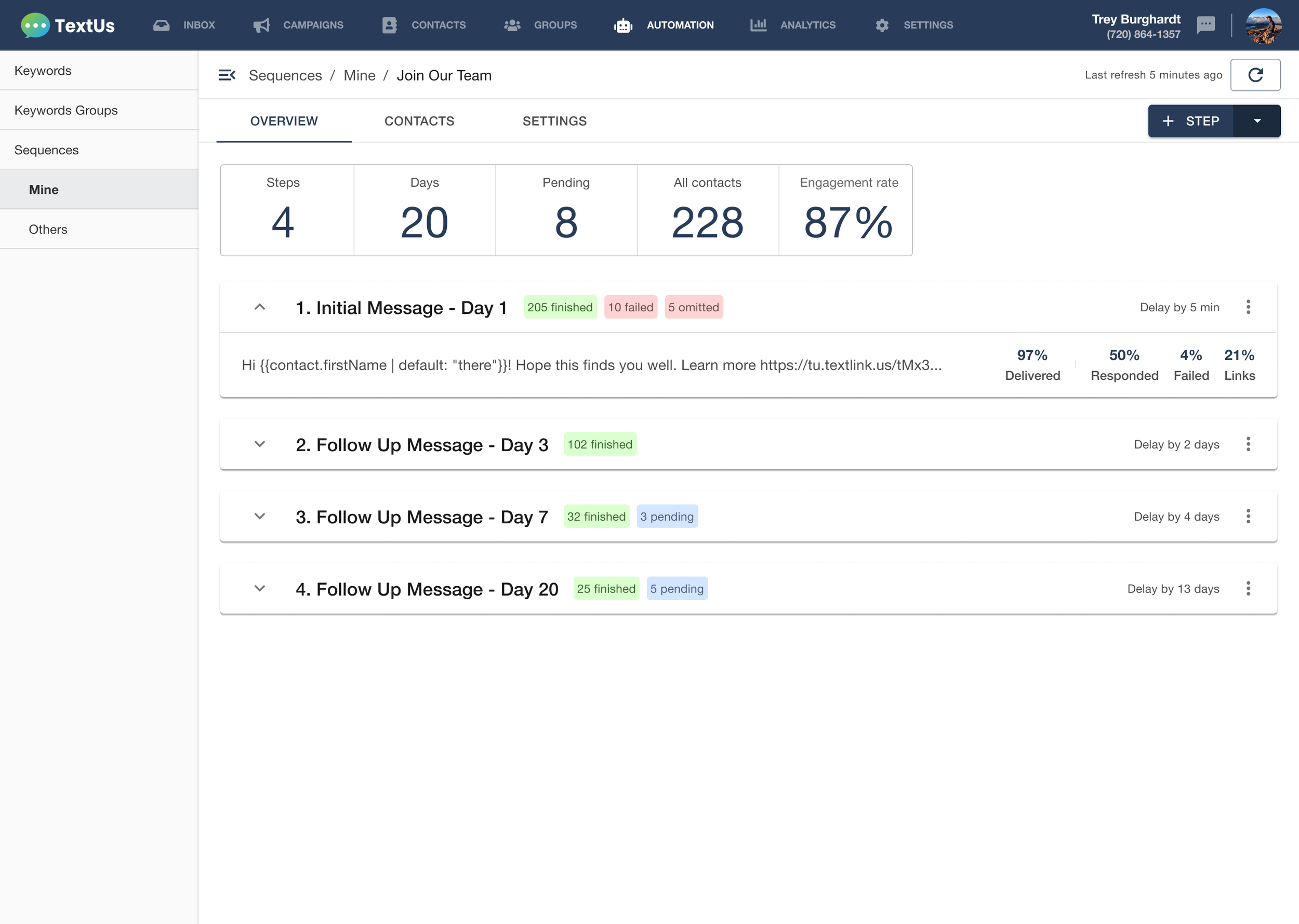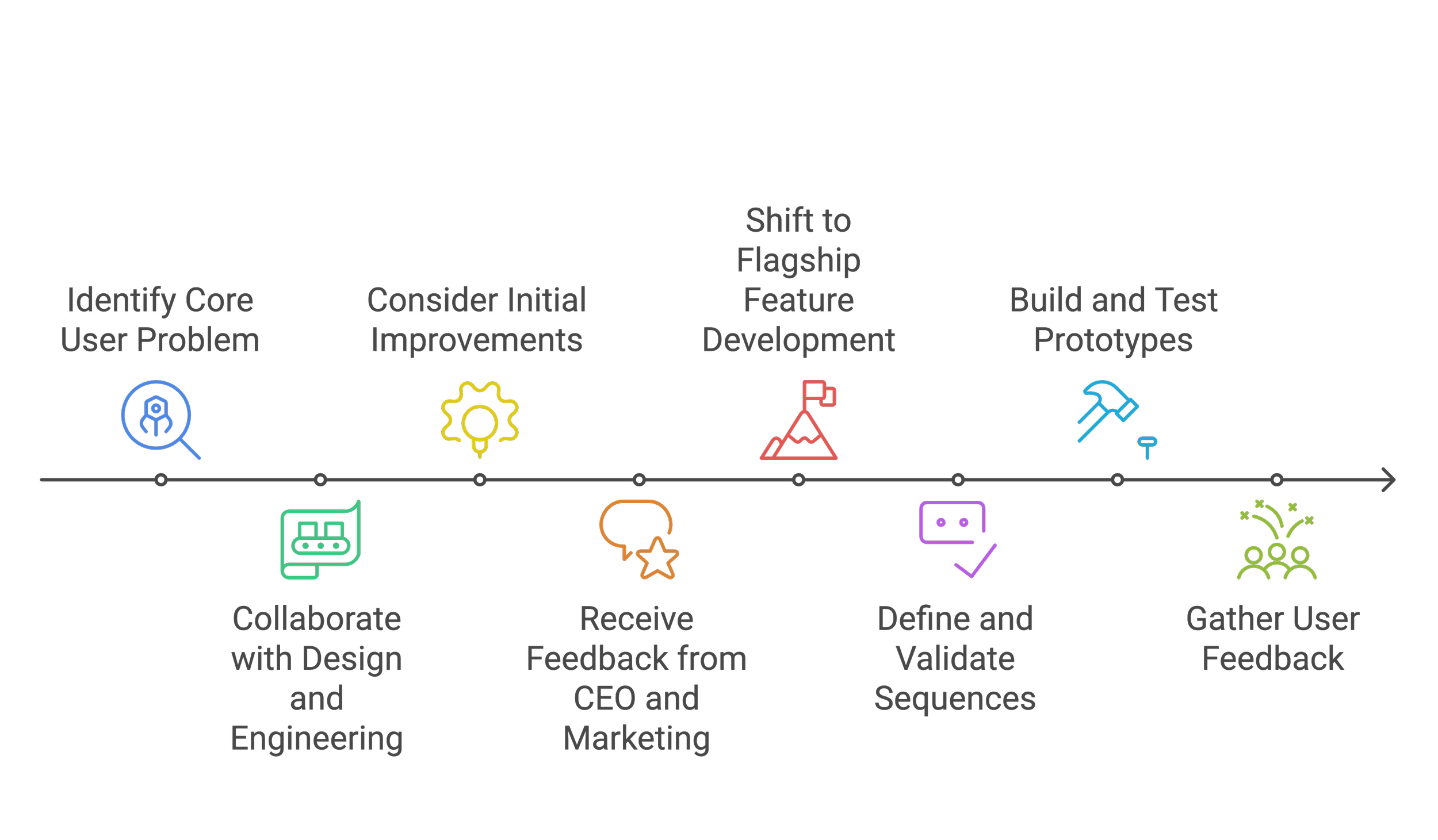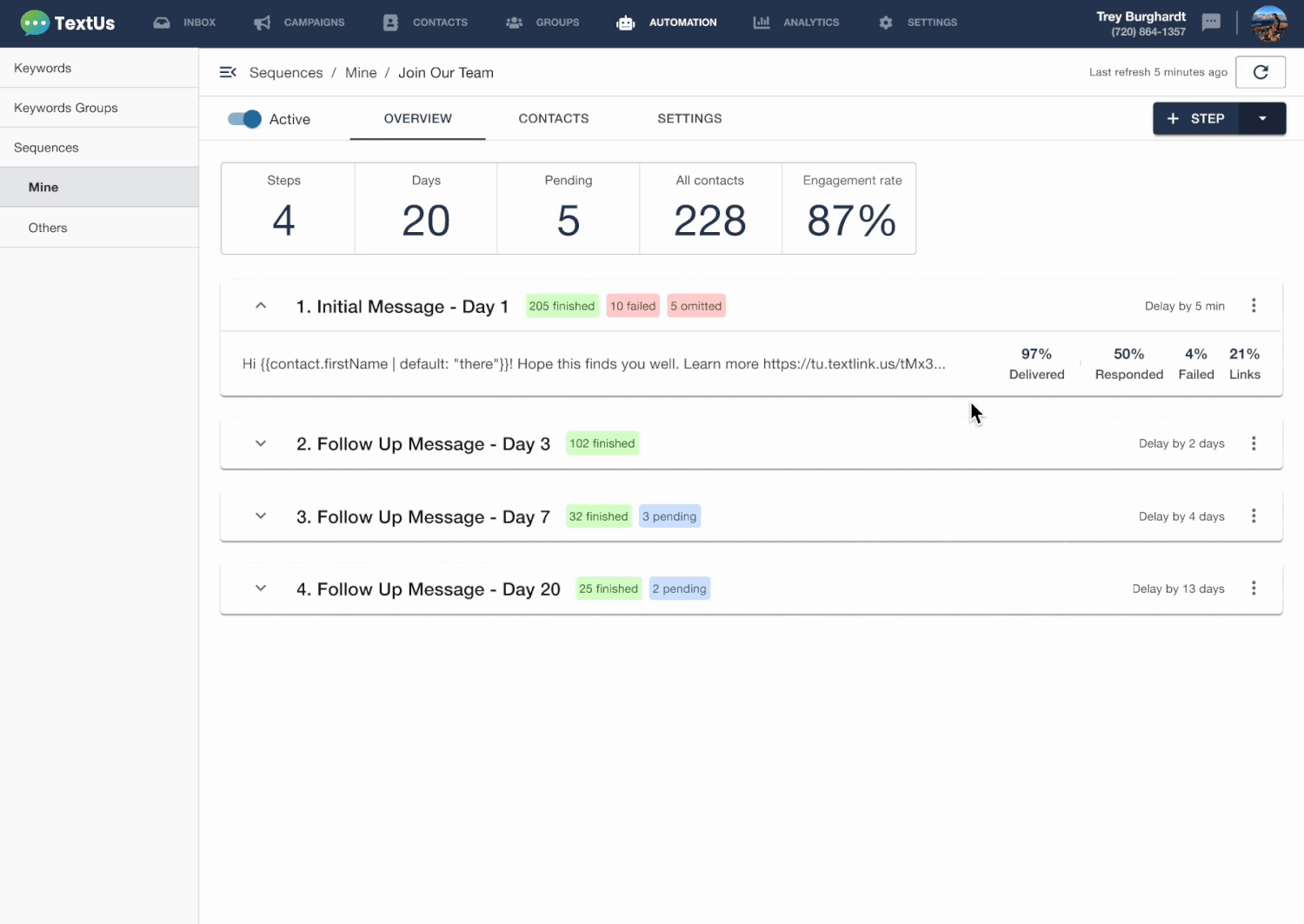Sequences
0 to 1 Automation & Revenue Growth
41% Reduction in churn
27% Increase in engagement
44% Attach rate for premium upsell
As the Product Manager for Sequences, I led the end-to-end discovery, definition, development and release of an automation feature designed to streamline contact outreach and engagement. This case study explores how I identified a critical gap in our product, collaborated cross-functionally to bring Sequences to market, and drove adoption to position it as a key differentiator for TextUs.
Timeline
Q3 2022 - Q2 2023
Other Contributors
SVP Product, Product Designer, VP of Account Management
Business goals
Greatly reduce churn
Generate new interest in the product
Create a higher margin premium feature to upsell
Press about Sequences
Blog post | Jul 19, 2023
Press release | Jul 24, 2023
Blueprints release | Nov 30, 2023
Uncovering the User’s Pain Points
I knew the business impact—40% of churning customers cited a lack of automation, costing $1.7M in lost revenue. But to build the right solution, I needed to go beyond the numbers and uncover the real, day-to-day frustrations driving customers away.
Through customer interviews, product analytics, and support ticket analysis, I identified three core pain points:
Tedious, Manual Follow-Ups – Users spent hours tracking and re-engaging contacts, leading to burnout and inconsistency.
Missed Revenue Opportunities – Without automated touchpoints, leads went cold, and job placements stalled.
Disjointed Workflows – Users patched together clunky workarounds, creating inefficiencies and frustration.
The ask wasn’t just for "automation"—it was for a smarter, effortless way to nurture relationships at scale. These insights shaped the vision for Sequences, ensuring we built not just another feature, but a game-changer for contact engagement.
15+ customer interviews – Identified key automation gaps and workflow inefficiencies.
10+ stakeholder meetings – Gathered insights from Sales, Customer Success, and Support.
Competitor analysis – Evaluated automation capabilities to identify market gaps.
Pendo analytics – Tracked drop-off points in manual workflows to validate user friction.
Problem Statement
40% of churning customers cited the lack of automation as their primary reason for leaving, resulting in a $1.7M revenue loss. Customers need a scalable, efficient way to automate follow-ups and improve engagement, but TextUs lacks a built-in solution to meet this demand, pushing them to seek alternatives.
Solutioning and Validation
With a clear understanding of the core user problem, I partnered with Product Design and Engineering to explore solutions. Initially, I considered incremental and quicker to deliver improvements—adding follow-up suggestions, engagement nudges for unresponsive contacts, and better product marketing to highlight existing automation features that weren’t explicitly positioned as automation.
However, feedback from the CEO and Marketing team shifted my approach. We needed more than just optimizations—we needed a flagship automation feature that would not only give Sales and Success teams a powerful new selling point but also lay the strategic groundwork for a scalable automation offering.
With this in mind, I led the definition and validation of Sequences, a multi-step, automated engagement tool designed to be powerful enough for advanced users yet intuitive enough for anyone to adopt seamlessly. Working closely with Product Design, we built and tested prototypes, gathering user feedback to refine the experience before development began.
Development and Release
To ensure Sequences met real user needs, I took an iterative, feedback-driven approach—building incrementally, validating with customers at every stage, and refining based on real-world usage.
How We Built & Released Sequences
Beta Testing & Real-World Validation – I launched an early Beta with key customers, gathering insights on usability, workflow fit, and automation effectiveness.
Live Demos for At-Risk Customers & Prospects – Throughout development, I actively demoed Sequences to customers at risk of churning and potential new clients, using their feedback to refine the product while reinforcing our investment in automation.
Tight Feedback Loops & Rapid Iteration – By maintaining a constant feedback cycle with Beta users, internal teams, and Sales/Success stakeholders, I adapted quickly—fine-tuning UX, addressing gaps, and prioritizing high-impact improvements.
Phased Rollout & Adoption Strategy – Instead of a single large release, I rolled out Sequences in stages, ensuring each milestone delivered tangible value while allowing us to optimize performance before a full-scale launch.
This agile, customer-centric development approach helped me not only build the right automation solution but also drive early adoption and market excitement before the official launch.
Adoption and Fast Follow Improvements
Adoption started slow since Sequences was a paid feature upgrade, but within the customers who had access, it quickly became a highly used, high-value tool.
Key Enhancements Based on User Feedback:
Delivery Windows – Customers wanted control over when messages were sent, so we added delayed sending to ensure follow-ups landed at the right time.
Blueprints – Setting up Sequences from scratch was time-consuming, so we introduced pre-built templates to help users launch faster and customize easily.
By iterating quickly post-launch, we made Sequences more flexible, easier to adopt, and a stronger automation tool for engagement.
Outcomes
📉 41% Reduction in Churn – Sequences tackled a top churn driver head-on, significantly improving customer retention.
📈 27% Increase in Engagement – Automated follow-ups led to more responses, more conversations, and more conversions.
💰 44% Attach Rate for Premium Upsell – Sequences wasn’t just adopted—it became a high-value revenue driver.
⚡ Faster Onboarding & Adoption – Blueprint templates cut setup time, making automation accessible to more users, faster.
🚀 Strengthened Market Position – Sequences positioned TextUs as a leader in automation, proving we could scale engagement intelligently.
Key Takeaways
🔍 Small Fixes Don’t Solve Big Problems – Customers didn’t just want nudges—they needed a true automation engine.
🗣 User Feedback Drives Real Innovation – Live demos, Beta testing, and direct customer insights turned Sequences into a must-have, not just a nice-to-have.
💡 Premium Features Need the Right Strategy – Adoption wasn’t just about value—it was about pricing, positioning, and sales enablement.
📊 Launch is Just the Beginning – Delivery Windows and Blueprints proved that the best products aren’t just built—they’re iterated into greatness.
🔥 Automation is Now a Competitive Advantage – Sequences didn’t just fill a gap—it set the foundation for the future of engagement at TextUs.






